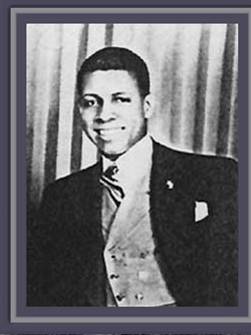
|
Hayes PillarsJazz saxophone and orchestra leaderBirth: Death: August 11, 1992 Birthplace: Little Rock, Arkansas Date of Interview: 1981 Place of Interview: Narrator's Home Interviewer: Charles E. Rose |
Hayes Pillars began playing saxophone as a teenager. In January 1934 he and his friend, James Jeter, organized the Jeter-Pillars Orchestra while in Cleveland, OH. On July 4, 1934 the orchestra came to play a six-week engagement at the Club Plantation in St. Louis; they were so popular they stayed eleven years. The group also played at the Club Riviera on Delmar Blvd as well as at the Apollo Theater in New York, and at jazz clubs in Chicago. After the group disbanded, Mr. Pillars continued to play for more than thirty years for private parties and in area country clubs. He retired in the early 1980's. In 1981, the Institute for Jazz Studies at Rutgers University and the Smithsonian Institute in Washington, D.C. honored him for his contributions to American Jazz.
This is the table of contents for the interview of Hayes Pillars. It is part of the National Ragtime and Jazz Archive which is located in Lovejoy Library at Southern Illinois University Edwardsville.
For a complete contents list of all musician interviews for the oral history project, please click on this link: Oral History and Research Materials.
If interested in reviewing these materials from the National Ragtime and Jazz Archive, please contact Therese Dickman, Fine Arts Librarian.
|
Tape # Side |
Time |
Subject |
|
1 a |
000-026 |
E arly life; interest in music |
|
1 a |
027-089 |
Saxophone; learning music
|
|
1 a |
090-120 |
First band
|
|
1 a |
121-0140 |
Second band; own band
|
|
1 a |
141-178 |
First St. Louis job; Club Plantation
|
|
1 a |
179-203 |
Band personnel
|
|
1 a |
204-250 |
Musician's unions
|
|
1 a |
251-278 |
Position of Jeter - Pillars band in St.Louis; other
|
|
1 a |
279-348 |
Bands prominent at that time jazz - origin of - how
|
|
1 a |
349-372 |
Ragtime music - influence on jazz
|
|
1 a |
373-397 |
Jeter - Pillars band - type of music
|
|
1 a |
398-414 |
Development of jazz
|
|
1 a |
415-470 |
St. Louis "style"; late teen, early twenties
|
|
1 a |
471-490 |
R ace problem; white bands
|
|
1 a |
491-500 |
Other clubs and bands
|
|
1 a |
501-543 |
"Black" music vs. "white" music; American jazz
|
|
1 a |
544-580 |
Early jazz in St. Louis
|
|
1 a |
581-615 |
Rhythm and blues; blues; rock and roll
|
|
1 a |
616-629 |
Dissolution of band
|
|
1 a |
630-727 |
Government tax on dance clubs; effect on big bands
|
|
1 a |
728-770 |
Problems facing black musicians
|
|
1 a |
771-781 |
Technique and tone
|
|
1 a |
782-823 |
Music structure
|
|
1 a |
824-857 |
Black and white musicians
|
|
1 a |
858-879 |
Gus Wilson
|
|
1 a |
880-915 |
Drugs and bad environment surrounding musicians
|
|
1 a |
916-940 |
Bands popular around St. Louis
|
|
1 a |
941-962 |
P opularity of Jeter - Pillars Band
|
|
1 a |
963-977 |
Nationally know musicians who played in St. Louis |
|
2 a |
002-089 |
"Swing" music, Benny Goodman
|
|
2 a |
090-117 |
Fletcher Henderson Band
|
|
2 a |
118-130 |
Druie Bess
|
|
2 a |
131-167 |
Tone and technique
|
|
2 a |
168-269 |
St. Louis Contribution to jazz
|
|
2 a |
270-295 |
Enjoyment of music |
E-mail comments and inquiries about the National Ragtime and Jazz Archive to Therese Dickman at tdickma@siue.edu or call 618-650-2695.